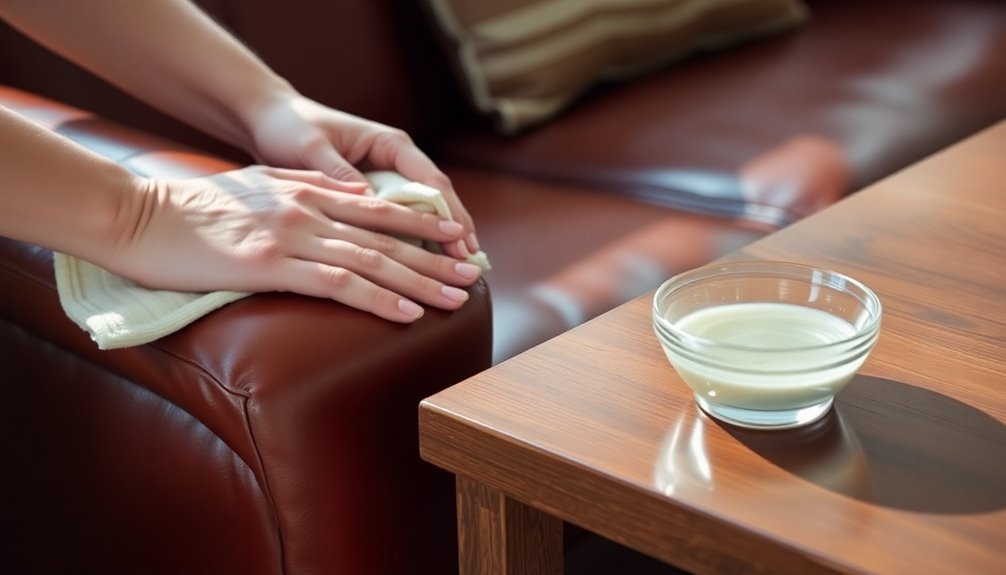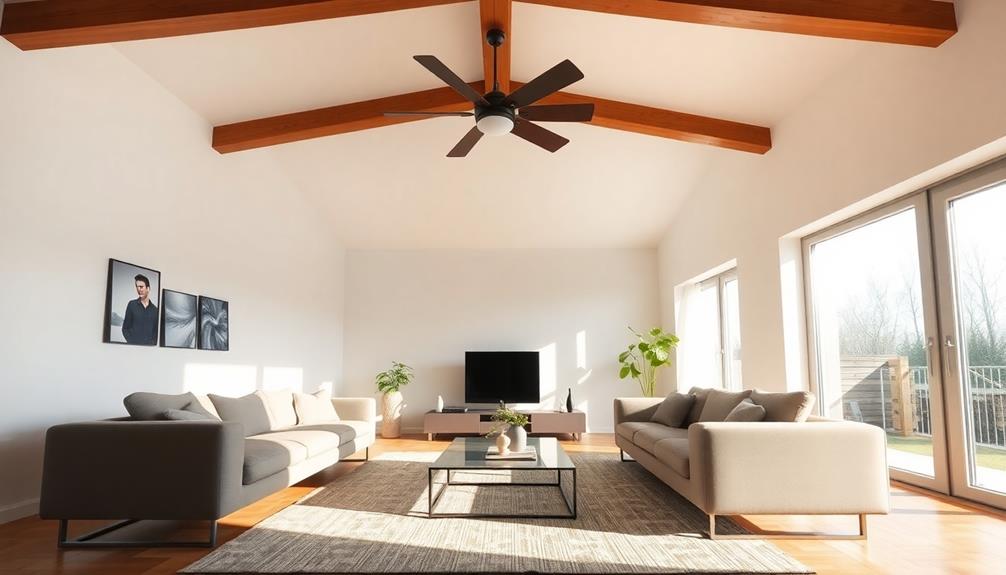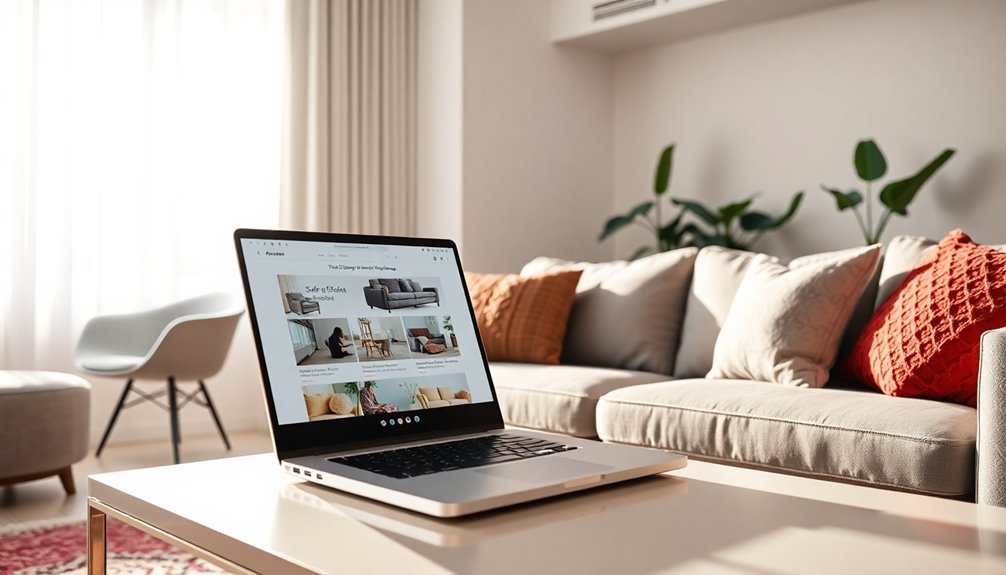To take care of your leather sofa, start with regular dusting using a soft cloth and vacuum the crevices every month. Clean spills immediately with a damp cloth to prevent damage. Use a pH-balanced leather cleaner every 6-12 months and condition the leather twice a year to keep it soft and supple. Protect against sunlight by positioning the sofa away from direct rays and applying leather protectant every few months. Inspect the stitching for wear and schedule repairs promptly. By following these tips, you'll maintain its beauty and longevity, and there's more to discover about advanced care techniques.
Key Takeaways
- Regularly dust and vacuum your leather sofa to prevent dust buildup and debris accumulation.
- Clean spills immediately with a damp cloth and use a mild soap solution for deeper cleaning.
- Apply a leather protectant every 3 to 6 months to shield against UV rays and moisture damage.
- Inspect stitching and repair any wear and tear promptly to maintain structural integrity.
- Rotate seat cushions every few months for even wear and prolong the sofa's lifespan.
Introduction
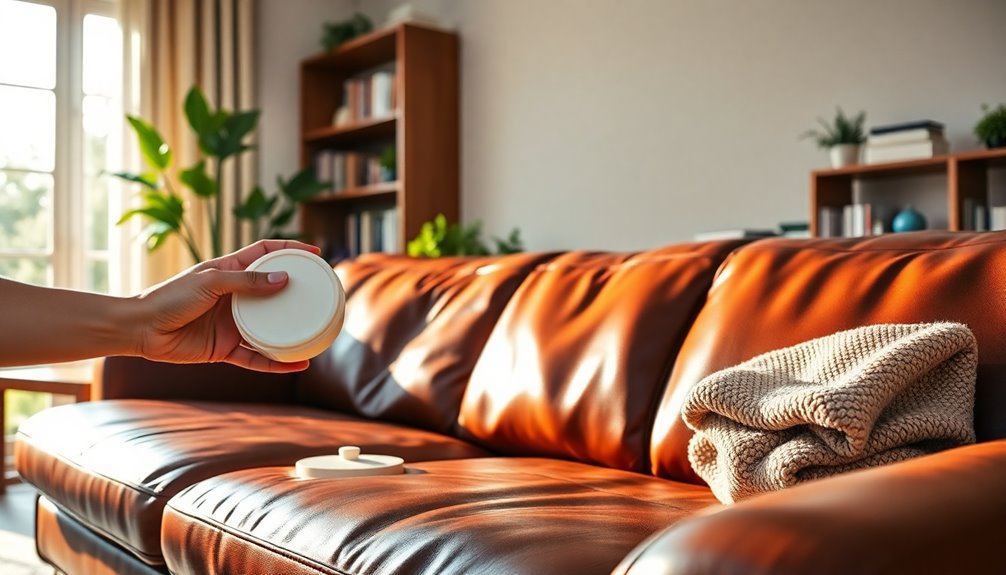
Taking care of your leather sofa is essential for its longevity and appearance. You'll want to establish a routine for dusting and wiping down the surface, use the right cleaning techniques, and know how to handle spills like wine effectively. By staying on top of these tasks, you can keep your sofa looking great for years to come.
Routine Dusting and Wiping
To keep your leather sofa looking its best, regular dusting and wiping are essential. Start with routine dusting using a soft, dry cloth or a microfiber cloth to prevent dust and dirt buildup. This simple step helps maintain the leather's luster and prevents dullness. Aim to vacuum the crevices every 2-4 weeks with a soft brush attachment to remove debris from hard-to-reach areas without causing any damage.
When it comes to cleaning leather, a barely damp cloth can be effective for removing light stains. Just make sure not to over-saturate the leather, as excess moisture can lead to damage. For deeper cleaning, consider using a mild soap diluted in water, but remember to follow up with a dry soft cloth to remove any residue.
Avoid harsh chemicals or abrasive materials during your cleaning routine, as these can strip the leather of its protective finish and lead to deterioration. Air purifiers can also help improve indoor air quality, protecting your leather from humidity and pollutants that may cause damage. By establishing a habit of routine dusting and wiping, you're not just enhancing the appearance of your sofa; you're also contributing to its longevity through proper leather care.
Fabric-Specific Cleaning Techniques
When it comes to cleaning your leather sofa, understanding the specific type of leather is crucial for effective care. Different leathers, like full-grain and top-grain, need unique cleaning products to avoid damage. Always opt for pH-balanced leather cleaners for the best results. For light cleaning, grab a barely damp cloth to dust off and remove debris without soaking the leather—excess moisture can lead to serious harm.
If you encounter stubborn stains, act quickly. Use a mild soap solution, gently blotting the area instead of scrubbing to protect the leather's finish. Monthly deep cleaning is essential for maintaining your sofa. Apply leather cleaner in circular motions with a soft cloth, ensuring even coverage to clean and condition the leather.
Always remember to test any cleaning solution on an inconspicuous area first. This precaution helps you check for discoloration before applying it to the entire surface. By following these fabric-specific cleaning techniques, you'll not only enhance the look of your leather sofa but also ensure lasting durability—a key aspect of effective Leather Furniture Care. Regular maintenance, including understanding vacuum cleaner attachments, can help keep your sofa free from dust and debris that may cause wear over time.
Tackling Wine Spills Effectively
Wine spills on a leather sofa can be daunting, but acting quickly can make all the difference. First, grab a clean, dry cloth and gently blot the spill to absorb as much liquid as possible. Avoid rubbing, as this can spread the stain and embed the wine deeper into the leather. Next, mix a solution of mild soap and water. Dampen a cloth with this mixture and gently clean the stained area, but be careful not to soak the leather, as excess moisture can cause damage.
If the stain persists, consider using specialized cleaning products designed for wine stains. Always follow the manufacturer's instructions and perform a spot test on an inconspicuous area first to check for any discoloration. After you've cleaned the stain, don't forget to apply a leather conditioner. This helps restore moisture and protects your leather sofa from future spills and dirt and grime.
Shielding Against Sunlight Damage
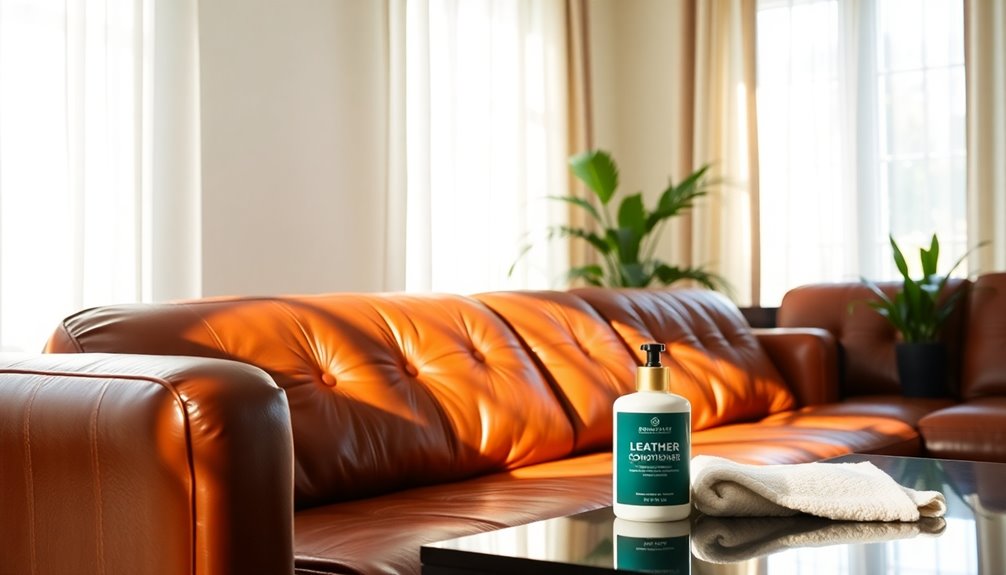
To protect your leather sofa from sunlight damage, consider scratch-resistant leather options that can withstand daily wear. You can also enhance its defense with decorative throws that not only shield it from UV rays but add a stylish touch. Regularly applying leather protectant will keep your sofa looking great while guarding against fading and cracking.
Scratch-Resistant Leather Options
Choosing the right leather for your sofa can make all the difference in its durability and appearance. Scratch-resistant leather options, like top-grain leather, are ideal for those who want a stylish sofa that can handle everyday wear and tear. These options maintain a sleek look while being tough against scratches. Although full-grain leather isn't inherently scratch-resistant, it develops a natural patina that can help disguise minor scratches over time.
To enhance the longevity of your leather furniture, consider applying protective coatings. These treatments boost scratch resistance and guard against the damaging effects of direct sunlight, which can lead to fading and cracking. Regular conditioning is also crucial; it keeps the leather supple and less prone to scratches. Additionally, you can protect your investment by utilizing window treatments to minimize direct sunlight exposure. This simple step can significantly reduce the risk of damage, preserving both the aesthetic and the longevity of your leather sofa. By making these informed choices, you'll ensure your leather furniture remains beautiful and functional for years to come. Moreover, utilizing sustainable practices in furniture care can help mitigate environmental impacts associated with production and disposal.
Protect With Decorative Throws
Using decorative throws is a smart way to shield your leather sofa from sunlight damage while adding a touch of style. Direct sunlight can fade and dry leather over time, but with the right throws, you can protect your investment. Choose throws made from breathable materials to ensure air circulation and prevent moisture buildup, which could lead to mold or mildew underneath.
These throws not only enhance your sofa's aesthetic but also provide practical benefits. They help protect your leather furniture from pet hair, dirt, and oils from your skin, reducing the frequency of cleaning needed. This means you can enjoy your sofa without worrying too much about maintenance.
To keep both your throws and leather sofa looking their best, remember to rotate and wash the throws regularly. This will help maintain their appearance and ensure they continue to offer protection. Opt for colors that complement your leather sofa, creating a cohesive look in your living space. By incorporating decorative throws into your care routine, you can enjoy a beautiful, protected leather sofa for years to come.
Using Leather Protectant Regularly
Applying leather protectant regularly is essential for maintaining your sofa's appearance and longevity. This protective barrier shields your sofa from harmful UV rays, reducing the risk of fading and drying out over time. To keep leather furniture looking its best, aim to apply a leather protectant every 3 to 6 months, depending on how much sunlight it gets.
When selecting a protectant, choose products specifically designed for leather to ensure compatibility and effectiveness. Using a cleaning kit that includes a leather protectant makes this process easier. Make sure to condition your leather before applying the protectant to nourish the material and enhance its durability.
To apply the protectant, use a soft cloth to evenly distribute the product across your sofa's surface, ensuring complete coverage. This not only helps repel moisture and stains but also provides additional defense against spills and environmental factors. By incorporating this simple routine, you'll significantly extend the life of your leather sofa while preserving its rich color and texture. Remember, a little maintenance goes a long way in protecting your investment!
Leather Stitching and Reinforcement

When it comes to leather sofas, weak seams and joints can lead to bigger problems down the line. By keeping an eye on the stitching and addressing any issues early, you can avoid costly leather repair and refinishing. Plus, maintaining the softness and shine of the leather helps preserve the integrity of those crucial seams.
Weak Seams and Joints
Weak seams and joints in a leather sofa can seriously compromise its durability and aesthetic appeal. Regular inspections of your furniture are crucial; look out for any weak seams or signs of fraying and loose threads. These issues can indicate that your sofa needs immediate attention to prevent further damage.
High-quality leather sofas often feature double-stitched seams, which provide enhanced strength compared to single-stitched options. If you notice weak seams, applying a leather conditioner can help maintain the flexibility of the leather, reducing the risk of cracking or breaking over time. This simple step not only nourishes the leather but also helps protect the seams from premature wear and tear.
If your inspections reveal any weak seams that need repair, don't hesitate to consult a professional upholsterer. They can reinforce the stitching to restore the structural integrity of your sofa, ensuring it remains an attractive centerpiece in your living space. Additionally, regular maintenance and care can significantly enhance your sofa's lifespan by preventing common issues associated with leather furniture, such as cookie usage for tracking visitor interactions. Taking these proactive measures will keep your leather sofa looking great and functioning well for years to come. Remember, a little maintenance goes a long way in preserving your investment.
Leather Repair and Refinishing
A leather sofa's longevity often hinges on proper repair and refinishing techniques, particularly in areas where stress is highest. One key aspect of leather repair is stitching, which reinforces seams to prevent fraying or separation. When you notice any wear, it's crucial to act quickly. Using high-quality, color-matched thread during the stitching process not only ensures durability but also maintains the leather's appearance.
In addition to stitching, consider employing reinforcement techniques, such as adding patches or utilizing leather adhesive, to address areas of significant wear. These methods can effectively restore the structural integrity of your sofa and prolong its lifespan. Regularly inspecting and reinforcing stitching and seams can significantly reduce the likelihood of extensive damage, so don't overlook this aspect of maintenance.
For optimal results, you might want to hire a professional leather technician. Their expertise in repairing and refinishing can guarantee that the work blends seamlessly with your existing leather, preserving its aesthetic. Remember, timely leather repair is essential for keeping your sofa in excellent condition and maintaining its luxurious look for years to come. Additionally, a professional leather technician can advise you on routine maintenance to prolong the life of your leather items. If you also have outdoor furniture, consider seeking an expert in repairing wicker patio furniture to ensure that all aspects of your home remain in top shape. By addressing repairs promptly and choosing skilled technicians, you can enjoy a beautiful and cohesive living space that reflects your style.
Revitalizing Softness and Shine
Maintaining the integrity of your leather sofa goes hand in hand with revitalizing its softness and shine. Regularly check the stitching for signs of wear or fraying. Damaged stitches can compromise both the structural integrity and appearance of your furniture. If you notice any loose or damaged stitching, reinforce it promptly. You can use a specialized leather repair kit or consult a professional for repairs.
Proper conditioning is crucial. Ensure that the leather is regularly conditioned to maintain its moisture, which helps preserve the elasticity of the stitching and prevents cracking around seams. When cleaning, stick to pH-balanced leather cleaners to keep the leather furniture clean without weakening the stitching. Harsh chemicals can do more harm than good.
To enhance the softness and shine of your sofa, apply a high-quality leather conditioner. This not only revitalizes the leather but also acts as a leather protector, shielding the stitching from drying out. By following these steps, you'll keep your leather sofa looking vibrant while ensuring the longevity of both its appearance and structure.
Personalized Leather Color Options
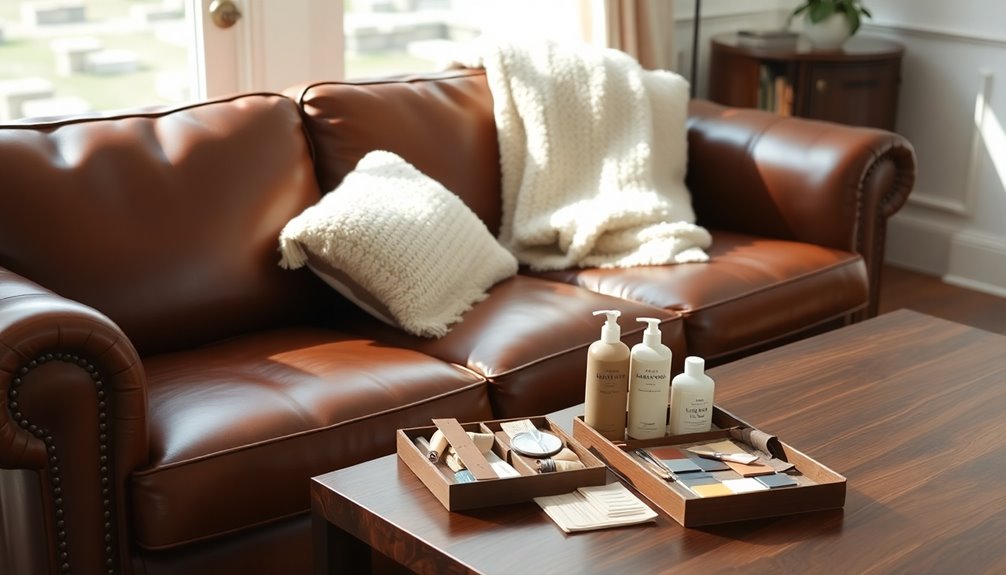
When it comes to personalizing your leather sofa, the color options are nearly limitless. You can choose from a wide range of hues that ensure your sofa matches your interior decor perfectly. Many brands offer customizable leather swatches, allowing you to see and feel the texture and color before finalizing your choice.
Both full-grain and top-grain leathers are often available in various colors, showcasing the natural beauty and unique characteristics of the hide. If you're looking for something special, some manufacturers provide options to create gradient or two-tone effects, adding a unique and personalized touch to your leather sofa.
Customization services typically include consultations with design experts who can assist you in selecting the ideal color and texture that aligns with your preferences. Whether you want a bold statement piece or a subtle complement to your existing decor, these personalized leather color options can transform your sofa into a true reflection of your style. So, take your time exploring the possibilities, and don't hesitate to ask for guidance from those who specialize in leather design. Your perfect sofa awaits!
Seasonal Leather Maintenance Tips

Throughout the year, your leather sofa needs specific care to keep it looking its best. In spring, kick off the season with a thorough cleaning. Use a vacuum to remove dust and follow up with a pH-balanced leather cleaner. This is essential for removing grime accumulated during the winter months.
As summer rolls in, protect your leather furniture in direct sunlight. Use curtains or blinds to prevent fading and brittleness caused by high temperatures. In fall, apply a high-quality leather conditioner to maintain suppleness and shield against the drying effects of indoor heating during winter.
During winter, keep a close eye on humidity levels. A humidifier can help maintain ideal humidity—around 40-60%—to prevent your leather from cracking. Additionally, regularly rotate seat cushions every few months. This simple tip for cleaning helps ensure even wear, prolonging the life of your leather sofa throughout the changing seasons.
Conclusion

Taking care of your leather sofa is essential for preserving its beauty and longevity. By implementing a few simple maintenance routines, you can keep your sofa looking its best for years to come. Regular cleaning every 2-4 weeks with a soft cloth and a pH-balanced leather cleaner will help maintain its appearance and prevent dirt buildup. Don't forget to condition your leather sofa at least twice a year with a quality leather conditioner to preserve its suppleness and prevent cracking.
Additionally, it's vital to protect your leather sofa from direct sunlight and extreme temperatures. Aim to maintain a controlled environment between 60°F and 77°F with humidity levels around 40% to 60%. When spills occur, respond immediately by blotting with a clean cloth—avoid scrubbing, as this can cause permanent damage.
Lastly, rotating seat cushions every three months will ensure even wear and extend the lifespan of your leather sofa. By following these straightforward maintenance tips, you can enjoy your leather sofa for many years, keeping it beautiful and functional in your home.
Frequently Asked Questions
How to Keep a Leather Sofa in Good Condition?
To keep your leather sofa in good condition, you should dust it regularly with a soft cloth to prevent dirt buildup. Blot spills immediately with a damp cloth, using mild soap for tougher stains. Condition the leather twice a year to maintain its suppleness, and ensure it's away from direct sunlight. Rotate the seat cushions every few months to avoid uneven wear. Lastly, maintain a humidity level of 40-60% to prevent drying.
How Do I Keep My Leather Couch From Cracking?
To keep your leather couch from cracking, you need to regularly clean it with a soft, dry cloth to eliminate dust and dirt. Apply a high-quality leather conditioner every six months to retain moisture and suppleness. Keep the couch in a controlled environment, avoiding extreme temperatures and humidity. Protect it from direct sunlight and heat, and consider using protective covers when it's not in use to shield against damage.
What Should You Not Put on a Leather Couch?
You shouldn't put harsh chemicals like bleach or ammonia on your leather couch, as they can ruin the finish. Avoid oil-based products, too, since they leave a greasy residue that attracts dirt. Don't use dish soap or detergent; they strip essential oils and may cause cracking over time. Also, keep wet items away to prevent moisture damage, and steer clear of abrasive materials that can scratch the leather surface.
Do Leather Couches Need to Be Oiled?
No, leather couches don't need to be oiled. In fact, applying oil can make your couch look greasy and attract dirt. Instead, you should use a high-quality leather conditioner every six months to keep it supple and prevent cracking. These conditioners moisturize without leaving any oily residue, ensuring your leather stays breathable and soft. Just remember to do a spot test first to avoid any unwanted changes in color or texture.
